|

|
Sanctuary staff from left to
right: Shelley Du Puy, Education Coordinator; G.P.
Schmahl, Sanctuary Manager; Emma Hickerson,
Research Coordinator. (photo: Frank and Joyce
Burek)
|
|
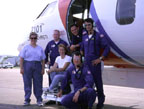
|
The Coast Guard Air Station
in Corpus Christi, Texas, have been working closely
with the Flower Gardens office to conduct fly-overs
of the Sanctuary on a regular basis. click image
for more...(photo: FGBNMS)
|
|
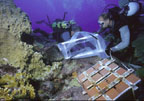
|
Coral reef researchers Carl
Beaver and Hector Guittierez secure a rack of tiles
to the exposed reef rock. Derek Hagman and Peter
Vize, also of the University of Texas, collect
coral gametes click image for more...
(photo: Ed Enns)
|
|
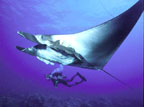
|
Sanctuary Research
Coordinator, Emma Hickerson, videos a juvenile male
manta ray (Manta birostris) at one of the Flower
Garden Banks. Texas A&M Marine Ecologist, Jeff
Childs, click image for more... (photo:
Kaile Tsapis)
|
|
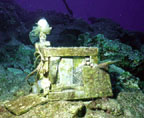
|
Over the past 20 years the
coral community at the Flower Gardens has been been
monitored. A contract between NOAA and MMS
(Minerals Management Service) click image for
more... (photo: Frank and Joyce Burek)
|
|
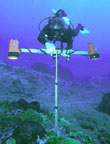
|
Repetitive photography
stations have been set up on each bank. Photographs
at these stations are taken on an annual basis
using a t-frame set up such as the one shown in
this picture. These images are digitized, thus
allowing researchers to measure the click image
for more... (photo: Frank and Joyce
Burek)
|
|
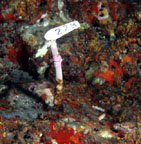
|
Pins, such as these one, have
been placed on the reef, so that repetitive photos
may be taken on an annual basis. These images are
digitized, thus allowing researchers to measure the
growth or regression of the corals, the amount of
click image for more... (photo: Frank and
Joyce Burek)
|
|

|
Semi-Permeable Membrane
Devices (SPMD's) are housed in cages such as shown
here, and placed at different depths of the
click image for more... (photo: Frank and
Joyce Burek)
|
|

|
Some possible threats to the
Sanctuary include illegal anchoring, illegal
fishing gear, or cable damage. This damage was
caused by an unknown source. Sanctuary personnel
are learning about how to restore corals like this
that have been damaged. (photo: Frank and Joyce
Burek)
|
|
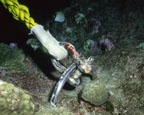
|
In the early 1990's,
recreational divers were concerned enough to take
on the task drilling u-bolts into the reef rock to
hold permanent mooring buoys. This is an example of
a u-bolt of one of the Flower Garden Banks click
image for more... (photo: Frank and Joyce
Burek)
|
|
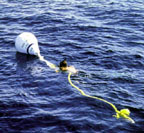
|
Mooring buoy attached to
Ubolt. It is illegal to drop anchor onto the reef,
unless no Sanctuary resource is harmed. (photo:
Frank and Joyce Burek)
|
|
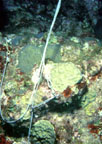
|
Fishing rigs are often caught
up on the reef by recreational fishermen. Hook and
line fishing is permitted at the Flower Gardens. No
spear fishing, or bottom long lining, or trawling
is allowed. (photo: Frank and Joyce Burek)
|
|

|
Large juvenile Loggerhead sea
turtles, Caretta caretta, are the most common sea
turtle encountered at the Flower Gardens and
Stetson click image for more... (photo:
Frank and Joyce Burek)
|
|
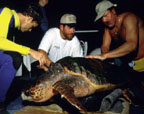
|
This animal, Triton, was
first captured in June of 1995, then again in June
1996, and finally in February 1997. He was seen
showing off his long tail on the surface in October
1998, and click image for more... (photo:
Greg Bunch )
|
|

|
Research Coordinator, Emma
Hickerson, takes blood from the dorsal sinus -
after running lab tests, we are able to determine
the sex of the juvenile animal. This animal
(Chocolate) turned out to be female. Lower
testosterone levels indicate a female. (photo:
Frank and Joyce Burek)
|
|
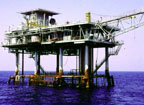
|
The name of this production
platform is High Island 389A (HI389A) - meaning
that it is located in the High Island lease block.
At present the lease is owned by Vastar. The
primary click image for more... (photo:
Frank and Joyce Burek)
|
|

|
An artificial coral reef is
used at events such as SeaSpace (Houston) to
educate children about marine life and the marine
environment. (photo: Frank and Joyce Burek)
|
|

|
Sanctuary personnel often are
asked to give presentation to school children or
dive clubs. Here, a group of school children
observe a live sea turtle that was brought over to
their school by Sanctuary staff. (photo:
FGBNMS)
|
|

|
Teachers are important
messengers for the Sanctuary. They participate in
many activities including an annual workshop and
dive trip to learn about Sanctuary resources so
they can enhance their classroom curricula. The
workshop includes classroom lectures, click
image for more... (photo: FGBNMS)
|
|

|
The annual education workshop
is sponsored by the Gulf of Mexico Foundation and
includes 18 educators. An advanced workshop for
alumni of previous workshops is also scheduled for
1999. (photo: FGBNMS)
|
|

|
Participants in the Teacher
at Sea Program spend time abourd NOAA research
vessels and assist with scientific field work such
as dissecting squirrel fish to collect samples for
DNA analysis. (photo: FGBNMS)
|
|

|
Students across Houston, TX
learned about the Flower Garden Banks while raising
$23,000 for radar reflecting buoys. Students
demonstrated what they learned on this exhibit at
SeaSpace,click image for more(photo:
FGBNMS)
|
|

|
Houston student accepts a
certificate acknowledging class efforts to raise
money for radar reflecting buoys at each of the
banks in the Sanctuary. (photo: FGBNMS)
|
|

|
Allen Academy (Bryan, TX)
students share with their classmates what they
learned during enrichment week. Each grade selected
a marine related topic to explore for several
weeks. click image for more... (photo:
FGBNMS)
|
|

|
Visitors to the San Luis Pass
County Park (Galveston, TX) learn about the
Sanctuary through live presentations, coral
skeleton samples, videos and brochures in the
park's visitor center. (photo: FGBNMS)
|
|

|
Participants in the Sea Space
Expo, kids attend talks to learn about fish
anatomy. Then they design their own fish using a
potato as the body and construction paper, other
materials as fins, gills, and eyes. (photo:
FGBNMS)
|
|

|
Artist Joel Hickerson teaches
children from 3 to 83 how to draw in his art class
at the annual Sea Space convention in Houston. This
session is called "Grouper got big ol' lips!"
(photo: FGBNMS)
|





